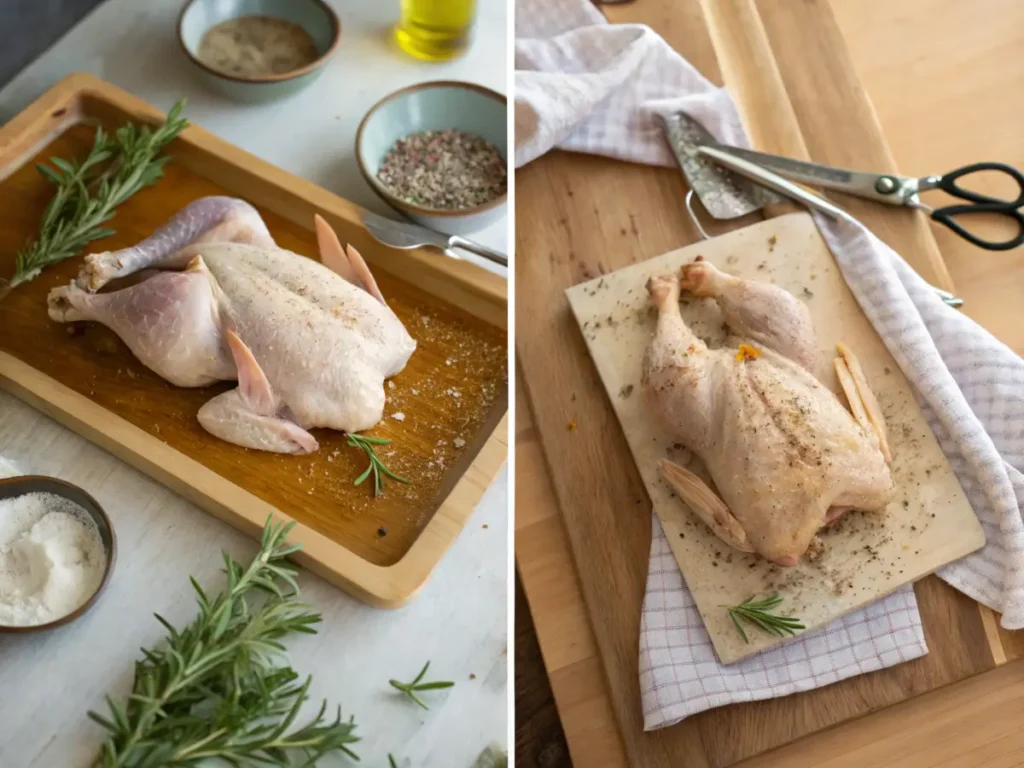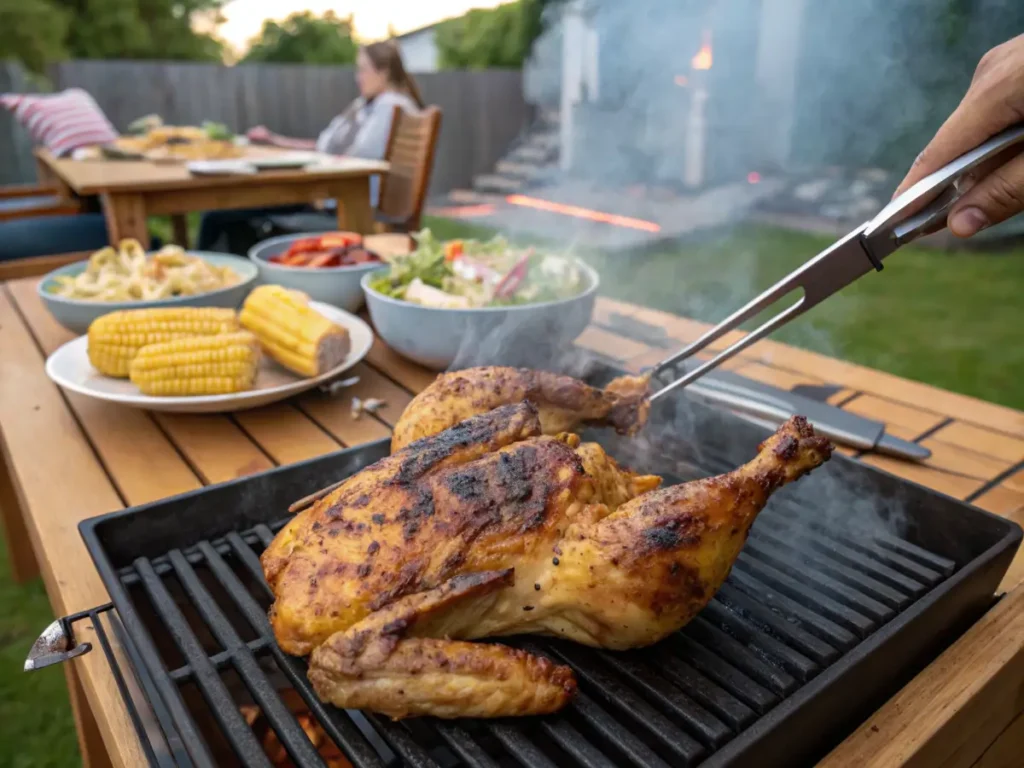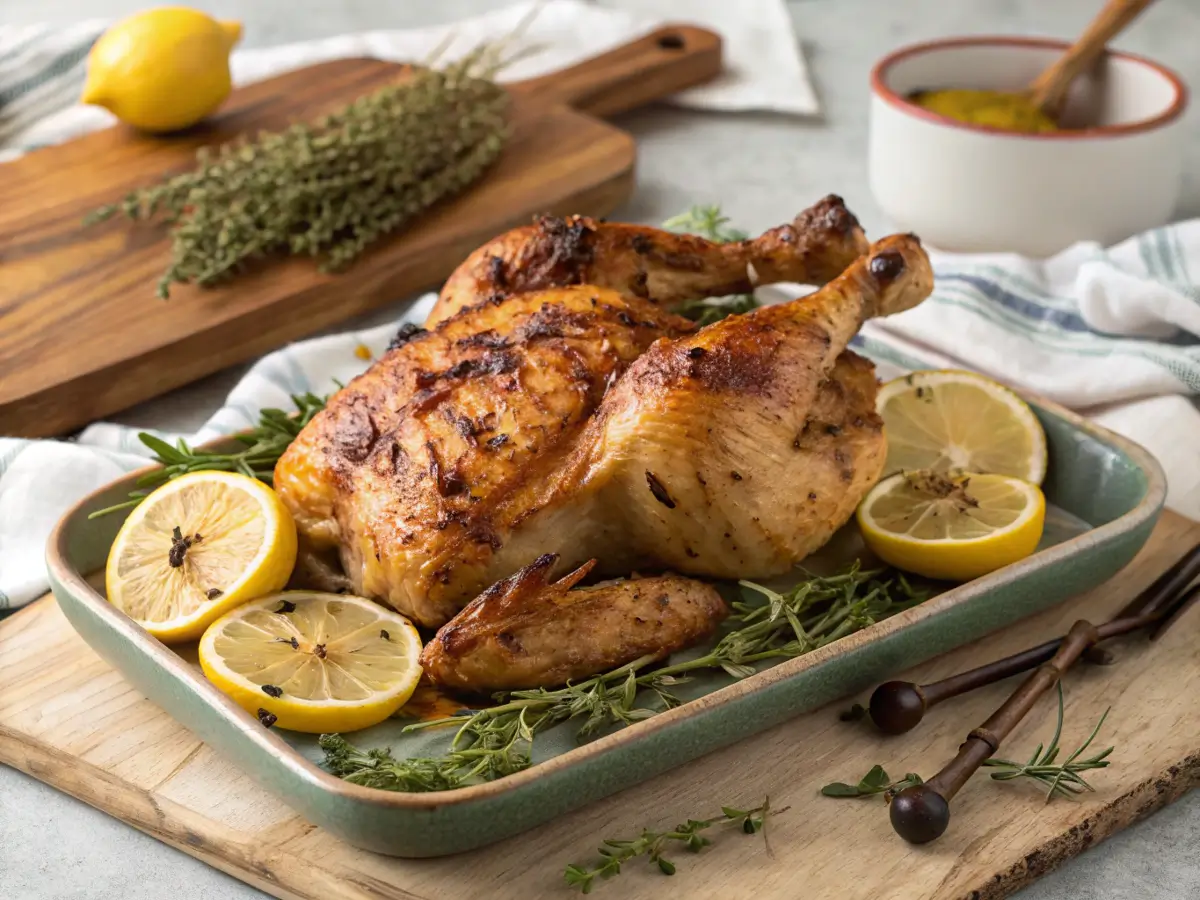Ever heard of butterflying or spatchcocking a chicken? It might sound fancy, but it’s just a clever way to prep your bird for cooking. By removing the backbone, you can lay the chicken flat, helping it cook more evenly and quickly. Whether you’re grilling, roasting, or smoking, this technique can make your chicken juicier and more flavorful. Plus, it’s not as tough as it sounds. Let’s dive into the world of butterflying and spatchcocking chickens, and see how it can change your cooking game.
Table of contents
Key Takeaways
- Butterflying and spatchcocking are the same technique for flattening a chicken.
- Removing the backbone helps the chicken cook evenly and faster.
- This method can be used for roasting, grilling, or smoking.
- A flat chicken allows for better seasoning and flavor absorption.
- Spatchcocking results in juicier meat and crispier skin.
Understanding the Basics of Butterflying and Spatchcocking Chickens
Definition and Differences
When it comes to preparing chicken, two techniques often come up: spatchcocking and butterflying. While they might sound fancy, they’re actually quite straightforward. Spatchcocking involves butterflying a whole chicken, allowing it to open like a book and lay flat. This method is ideal for roasting, grilling, or other cooking techniques, promoting even cooking and enhancing flavor. On the other hand, butterflying typically refers to splitting the chicken in half, which can be done with a sharp knife or kitchen shears.
To dive deeper into the advantages of spatchcock chicken, explore Discover What Makes Spatchcock Chicken Special.
Historical Background of butterflying and spatchcocking
The art of butterflying and spatchcocking has been around for centuries, with its roots tracing back to traditional cooking methods in Europe. Historically, these techniques were developed to ensure even cooking, whether over an open flame or in rustic ovens. Over the years, chefs and home cooks alike have increasingly embraced these methods due to their efficiency. Furthermore, they consistently deliver juicy and flavorful results, making them a timeless choice in kitchens worldwide.
Common Misconceptions
There are a few common misconceptions about these techniques. Some believe that spatchcocking is only for advanced cooks, but it’s actually quite accessible. Another myth is that a spatchcocked chicken will dry out. In reality, the opposite is true; the even cooking helps retain moisture. Lastly, many think that butterflying requires special tools, but a good pair of kitchen shears or a sharp knife is all you need.
Mastering how to butterfly a whole chicken in half or with a knife can open up a world of easy recipes and delicious meals. Whether you’re grilling or roasting, these techniques are sure to impress at your next dinner party.
Essential Tools for Butterflying and Spatchcocking
Kitchen Shears and Knives
When it comes to spatchcocking a chicken, having the right tools can make all the difference. A pair of sturdy kitchen shears is your best friend here. They should be sharp enough to cut through the chicken’s backbone with ease. Consider investing in a quality pair that can be taken apart for cleaning, ensuring hygiene and longevity. Alongside the shears, a sharp chef’s knife is essential. It’s perfect for making precise cuts and handling any additional trimming.
For a detailed guide on essential kitchen tools, check out Choosing the Right Kitchen Tools for Chicken Preparation.
Cutting Boards and Surfaces
The surface you work on is just as important as the tools you use. A large cutting board provides a stable base for your work. Opt for a plastic board, which is easier to sanitize than wood, reducing the risk of cross-contamination. Having a non-slip mat underneath can prevent the board from moving around as you cut.
Safety Tips and Precautions
Safety in the kitchen is paramount, especially when handling sharp objects. Always ensure your tools are in good condition, and keep them sharp to avoid accidents. Dull blades require more force and are more likely to slip. Use a damp cloth or paper towel under your cutting board to keep it steady. And remember, always cut away from your body to minimize the risk of injury.
Taking the time to prepare your workspace and tools properly not only makes the process smoother but also ensures a safer cooking experience for everyone involved.
Step-by-Step Guide to Spatchcocked Chicken

Preparing the Chicken
Start by getting your chicken ready for the spatchcocking process. Place the bird breast-side down on a stable cutting board. This position gives you easy access to the backbone, which is the first part you need to work on. Use paper towels to pat the chicken dry, both inside and out, ensuring a firm grip and reducing any slippery surfaces.
Removing the Backbone
Removing the backbone is the main step in spatchcocking a chicken. For this, you’ll need sharp kitchen shears. Begin cutting along one side of the backbone from the tail to the neck. Repeat the process on the other side of the backbone until you can remove it completely. If you struggle with the shears, a sharp knife can be a good alternative.
Flattening the Bird
With the backbone removed, it’s time to flatten the chicken. Flip the bird over so the breast side is up. Press down firmly on the breastbone until you hear a crack. This step ensures that the chicken lays flat, which is essential for even cooking. If you find it tough to crack the breastbone, try scoring it with a knife first, then press down again.
For additional techniques, visit How to Spatchcock Chicken Like a Pro.
Spatchcocking might seem a bit daunting at first, but once you get the hang of it, you’ll find it to be a quick and effective way to prepare chicken for cooking. This method not only promotes even cooking but also allows for more flavorful seasoning distribution.
Cooking Techniques for Spatchcocked Chicken
Grilling Methods for Spatchcocked Chicken

Grilling a spatchcock chicken is a fantastic way to get that smoky flavor while keeping the meat juicy. Start by preheating your grill to medium-high heat. Place the chicken skin-side down on the grill and cook for about 10-15 minutes. Flip it over and continue cooking for another 20-30 minutes until the internal temperature reaches 165°F. The key to grilling spatchcock chicken is to ensure even heat distribution, so it’s a good idea to use a two-zone grilling method, where one side of the grill is hotter than the other.
For tips on mastering spatchcock chicken cooking, refer to Mastering the Art of Spatchcock Chicken Cooking.
Oven Roasting Tips
Oven roasting is another popular method for cooking spatchcock chicken. Preheat your oven to 425°F. Lay the chicken flat on a baking sheet, preferably on a wire rack to allow air circulation. Roast for 40-45 minutes, basting occasionally with juices from the pan. This helps keep the chicken moist and enhances the flavor. You can also add vegetables around the chicken to cook simultaneously, making it a one-pan meal.
Smoking Techniques
For those who love a rich, deep flavor, smoking a spatchcock chicken is the way to go. Start by seasoning the chicken with your favorite rub. Preheat your smoker to 250°F and place the chicken inside. Smoke for about 2.5 to 3 hours, or until the internal temperature hits 165°F. Patience is crucial here, as smoking is a slow process that infuses the chicken with incredible flavor. You can use different wood chips like hickory or apple to experiment with flavors.
Cooking a spatchcock chicken is all about balancing time and flavor. Whether you grill, roast, or smoke, each method brings out unique tastes and textures. The flattened chicken ensures even cooking and allows flavors to penetrate deeply, making it a favorite for many home cooks.
Flavoring and Seasoning Your Spatchcocked Chicken

Marinades and Rubs
Getting the seasoning right can make or break your spatchcocked chicken. Marinades are a great way to infuse flavor deep into the meat, and they typically consist of a mix of oil, acid (like vinegar or lemon juice), and various seasonings. Let your chicken soak in the marinade for at least a couple of hours, or overnight if possible, to really let those flavors seep in.
Dry rubs, on the other hand, are a combination of spices and herbs that you rub directly onto the chicken. These are perfect if you’re looking for a more intense flavor. A basic dry rub might include salt, pepper, garlic powder, and paprika, but feel free to get creative with your favorite spices.
Herbs and Spices
When it comes to herbs and spices, the options are endless. Fresh herbs like rosemary, thyme, and parsley can add a subtle yet aromatic touch to your chicken. You can either chop them up and mix them into your marinade or rub, or stuff them under the skin for a more pronounced flavor.
Spices like cumin, coriander, and chili powder can give your chicken a more fantastic flair. If you like a bit of heat, don’t shy away from cayenne pepper or smoked paprika.
Sauces and Glazes for Spatchcocked Chicken
Adding a sauce or glaze towards the end of cooking can elevate your spatchcocked chicken to new heights. A honey mustard glaze can add a sweet and tangy finish, while a barbecue sauce can provide a smoky, savory layer of flavor.
For a simple glaze, mix honey, soy sauce, and a splash of vinegar. Brush it on during the last 10 minutes of cooking to avoid burning. This will give your chicken a beautiful, glossy finish and a burst of flavor with every bite.
Spatchcocking not only allows for even cooking, but it also opens up a world of flavor possibilities. Whether you prefer the deep penetration of a marinade or the bold statement of a dry rub, there’s a seasoning method to suit every palate. Learn how to prepare a butterflied spatchcocked chicken with various seasonings for a unique flavor profile.
Serving Suggestions and Pairings
Side Dishes to Complement
When it comes to serving a spatchcocked chicken, the sides can make all the difference. Here are some delicious options to consider:
- Roasted Vegetables: Think carrots, Brussels sprouts, or a medley of root vegetables. They bring out the natural flavors of the chicken.
- Cajun Roasted Chicken pairs beautifully with roasted garlic butter Parmesan potatoes or crispy baked potato wedges.
- Fresh Salads: A crisp cucumber salad or a tangy coleslaw can add a refreshing contrast to the rich flavors of the chicken.
Presentation Tips
How you present your spatchcocked chicken can enhance the dining experience:
- Slice with Precision: Use a sharp knife to carve neat portions, showcasing the juicy meat.
- Garnish Thoughtfully: Add sprigs of fresh herbs like rosemary or thyme for a pop of color.
- Serve Warm: Ensure the chicken is served hot to maintain its flavors and texture.
Tip: Presentation isn’t just about looks; it’s about making the meal feel special. A little effort goes a long way in creating a memorable dining experience.
Troubleshooting Common Issues
Uneven Cooking Solutions
Getting an evenly cooked spatchcocked chicken can be tricky. A common issue is uneven heat distribution. One solution is to use a broiler for a crispy finish, ensuring that the heat is evenly spread over the chicken. You might also want to adjust your cooking temperatures. Consider using a meat thermometer to monitor different parts of the bird. This can help you identify and fix hot spots on your grill or in your oven.
Avoiding Dryness
Nobody likes a dry chicken. To prevent this, marinating your chicken beforehand can help retain moisture. Another tip is to not overcook the chicken—keeping an eye on internal temperatures is key. Aim for a safe internal temperature of 165°F. Also, resting the chicken after cooking allows the juices to redistribute, keeping it juicy and flavorful.
Enhancing Crispy Skin
Crispy skin is often the highlight of a spatchcocked chicken. For the best results, pat the chicken dry with paper towels before cooking. You might also want to rub some oil or butter under the skin. Cooking techniques like smoking can also add a delightful crispiness. Try finishing the chicken off under a broiler for that extra crunch.
Cooking a spatchcocked chicken can be a rewarding experience, but it requires attention to detail. By addressing these common issues, you’ll be well on your way to mastering this technique.
Health Benefits and Nutritional Information of Spatchcocked Chicken
Caloric Content
When it comes to calories, a spatchcocked chicken can be a real treat without overloading your diet. On average, a serving of spatchcocked chicken contains around 250-300 calories, depending on the seasoning and cooking method. This makes it a great option for those keeping an eye on their calorie intake.
Protein and Nutrient Breakdown
Chicken is a powerhouse of protein, and when spatchcocked, it retains all its muscle-building benefits. A typical serving delivers about 25-30 grams of protein, making it an excellent choice for those looking to boost their protein intake. Additionally, chicken provides essential nutrients like B vitamins, selenium, and phosphorus, which are crucial for maintaining overall health.
Comparisons with Other Cooking Methods
Compared to other methods like frying, spatchcocking offers a healthier alternative. While fried chicken can be high in unhealthy fats, spatchcocked chicken, especially when grilled or roasted, keeps the fat content lower. This method also ensures even cooking, which can help in retaining more nutrients.
Spatchcocking isn’t just about quicker cooking times; it’s also about healthier meals. By allowing the chicken to cook evenly, you minimize the risk of undercooking and ensure that every bite is both delicious and nutritious.
For those looking to enjoy a savory spatchcock chicken, it’s a delightful dish that combines juicy meat with the added benefit of herbed vegetables, making it a well-rounded meal.
Wrapping It Up: Your Spatchcocking Adventure
So there you have it, folks! Spatchcocking and butterflying a chicken might sound fancy, but it’s really just a neat trick to get your bird cooked evenly and quickly. Whether you’re roasting, grilling, or smoking, this method is a total game-changer. No more dry chicken breasts or undercooked thighs—just juicy, flavorful chicken every time. Plus, it’s a great way to impress your dinner guests with your newfound kitchen skills. Give it a try next time you’re in the mood for chicken, and you’ll see what all the fuss is about. Happy cooking!
Frequently Asked Questions
What does Butterflying and Spatchcocking mean?
Butterflying and Spatchcocking refer to the same technique of removing a chicken’s backbone so it lays flat. This method helps the chicken cook evenly, reduces cooking time, and results in crispier skin.
Is Butterflying and Spatchcocking the same technique?
Yes! Butterflying and Spatchcocking are interchangeable terms. Both involve flattening the chicken by cutting out the backbone, making it ideal for grilling, roasting, or smoking.
Why should I try Butterflying and Spatchcocking my chicken?
There are several benefits to Butterflying and Spatchcocking a chicken:
Even Cooking: No more dry breast or undercooked thighs.
Crispier Skin: More surface area gets direct heat exposure.
Faster Cooking: A spatchcocked chicken roasts in nearly half the time of a whole bird.
Do I need special tools for Butterflying and Spatchcocking?
No special tools are required! Butterflying and Spatchcocking can be done using a strong pair of kitchen shears or a sharp chef’s knife. A sturdy cutting board is also recommended for safety.
Can I use Butterflying and Spatchcocking for other birds?
Absolutely! Butterflying and Spatchcocking work on turkeys, ducks, and even game birds like quail. The process is the same—remove the backbone and press down firmly to flatten the bird.
What should I do with the backbone after Butterflying and Spatchcocking?
Instead of discarding it, use the backbone for homemade chicken stock! After Butterflying and Spatchcocking, simmer the backbone with herbs and vegetables to create a flavorful broth.
How to Butterfly and Spatchcock a Chicken for Even Cooking
- Total Time: 1 hour (Oven/Grill) / 3.5 hours (Smoker)
- Yield: 4–6 servings 1x
Description
Butterflying or spatchcocking a chicken is a simple but effective technique that flattens the bird for faster and more even cooking. Whether you’re grilling, roasting, or smoking, this method ensures crispy skin and juicy meat every time. Learn how to properly spatchcock a chicken, the best cooking techniques, and tips for flavoring your bird to perfection!
Ingredients
- 1 whole chicken (4–5 lbs)
- 2 tablespoons olive oil or melted butter
- 1 teaspoon salt
- 1 teaspoon black pepper
- 1 teaspoon garlic powder
- 1 teaspoon smoked paprika
- 1 teaspoon dried thyme (or fresh sprigs)
- 1 teaspoon dried rosemary (or fresh sprigs)
- 1 lemon, sliced (for garnish)
- 4 cloves garlic, smashed (optional)
Instructions
Step 1: Prepare the Chicken
- Place the whole chicken breast-side down on a cutting board.
- Using kitchen shears, cut along one side of the backbone from tail to neck. Repeat on the other side and remove the backbone.
- Flip the chicken over and press down firmly on the breastbone until it cracks and the chicken lays flat.
Step 2: Season the Chicken
- Pat the chicken dry with paper towels.
- Rub with olive oil or melted butter to enhance crispiness.
- Season evenly with salt, black pepper, garlic powder, smoked paprika, thyme, and rosemary.
Step 3: Cooking Methods
Oven Roasting:
- Preheat the oven to 425°F (220°C).
- Place the chicken on a baking sheet with a wire rack for even air circulation.
- Roast for 40-45 minutes, or until the thickest part of the chicken reaches 165°F (74°C).
Grilling:
- Preheat the grill to medium-high heat (375-400°F).
- Grill the chicken skin-side down for 10-15 minutes, then flip and continue grilling for another 20-30 minutes.
Smoking:
- Preheat your smoker to 250°F (120°C).
- Smoke for 2.5 to 3 hours, until the internal temperature reaches 165°F.
Step 4: Rest & Serve
- Let the chicken rest for 10 minutes before carving.
- Serve with roasted vegetables, mashed potatoes, or a fresh salad.
Notes
- For Extra Crispy Skin: Let the chicken rest uncovered in the fridge for 1 hour before cooking.
- Best Flavoring Tip: Marinate the chicken overnight with herbs and lemon juice for deeper flavor.
- Dough Tip: Use homemade spice rubs for a signature taste.
- Prep Time: 15 minutes
- Cook Time: 40-45 minutes (Oven) / 45 minutes (Grill) / 2.5-3 hours (Smoker)
Nutrition
- Serving Size: 1/4 chicken
- Calories: ~320 kcal
- Sugar: 0g
- Sodium: 500mg
- Fat: 22g
- Saturated Fat: 6g
- Carbohydrates: 2g
- Fiber: 0.5g
- Protein: 30g
- Cholesterol: 110mg
Keywords: Spatchcock vs. butterfly chicken How to roast a spatchcocked chicken Best way to grill spatchcocked chicken Spatchcock chicken cooking time How to get crispy skin on a spatchcocked chicken
